Nuclear structure of neutron-deficient nuclei in the mass region A ≈ 180
I n a u g u r a l - D i s s e r t a t i o n zur
Erlangung des Doktorgrades
der Mathematisch-Naturwissenschaftlichen Fakultät der Universität zu Köln
vorgelegt von
Claus Müller-Gatermann aus Koblenz
Köln 2020
Berichterstatter: Prof. Dr. Alfred Dewald Prof. Dr. Peter Reiter
Prof. Dr. Rolf-Dietmar Herzberg Tag der letzten mündlichen Prüfung: 20. September 2019
| Abstract
To describe the nuclear structure of one or a group of nuclei several observables should be consulted.
The excitation energies of states with given spin and parity is often known and gives a good first impression. Nevertheless transition strengths of excited states are a much better probe, since they depend quadratically on the wavefunction. These can be determined in a model-independend way from the corresponding level lifetime.
Within this work a total of four experiments were performed to measure the lifetime of excited states in180Pt and178Hg. In the neutron-deficient mass region close to the shell closure at lead (Z=82) inter- esting phenomena such as shape coexistence and shape transitions are observed. The most prominent example is186Pb, which exhibits three different shapes. The ground state as well as two excited 0+ states together with the corresponding rotational bands are associated to multiparticle-multihole excitations resulting in the different shapes. A similar situation is established for the Hg isotopes near the neutron N=104 midshell, where the lightest isotope for which transition strengths are known is180Hg. Going further away from the shell closure the176,178,180Os isotopes are good candidates for the X(5) symmetry, i.e. the transition from spherical to axially deformed. Two questions arise:
How can the Pt isotopes just between Os and Hg be described and what is the evolution of shape coexistence in the Hg isotopes leaving neutron midshell?
Both questions are addressed within this thesis. 180Pt shows no remains of a X(5) like shape transition and multiparticle-multihole excitations are evident. This structure reaches the ground state and a new so-called island of inversion is found. This simultaneously answers the longlasting question whether configuration mixing is needed to describe the Pt isotopes or not. From the excitation energies178Hg is expected to be at the edge of the shape-coexistence region. The measured transition strengths confirm the shift of the structure with different shape to higher-lying states, but also a new phenomenon of intermediate deformation (between normal and superdeformation) shows up with decreasing neutron number. The interpretation is given by comparison to several existing calculations as well as particular calculations using geometrical models and the interacting boson model.
The experiments were carried out at different accelerator facilities employing the recoil distance Doppler-shift (RDDS) method, except one experiment when electronic-timing techniques were used to measure long lifetimes. Further a dedicated plunger apparatus was commissioned during one experiment. The GALILEOγ-ray spectrometer is the successor of GASP, which necessitated a com- pletely new mechanical design of the plunger. This fragile device newly allows the combination with charged-particle detectors, e.g. EUCLIDES.
| Zusammenfassung
Um die Kernstruktur eines oder mehrerer Kerne zu beschreiben, sollten mehrere Observablen her- angezogen werden. Die Anregungsenergien von Zuständen mit gegebenem Spin und Parität sind oft bekannt und liefern einen guten ersten Eindruck. Übergangsstärken von angeregten Zuständen liefern eine bessere Aussage, da sie quadratisch von der Wellenfunktion abhängen. Diese können modellunabhängig aus korrespondierenden Zustandslebensdauern bestimmt werden.
Innerhalb dieser Arbeit wurden insgesamt vier Experimente durchgeführt, um die Lebensdauer von angeregten Zuständen in180Pt und178Hg zu messen. Im neutronenarmen Massenbereich am Schalen- verschluss bei Blei (Z=82) werden interessante Phänomene wie Formkoexistenz und Formübergänge beobachtet. Das prominenteste Beispiel ist186Pb, das drei verschiedene Formen aufweist. Der Grund- zustand sowie zwei angeregte 0+-Zustände zusammen mit den entsprechenden Rotationsbanden können Teilchen-Loch-Anregungen zugeordnet werden, die zu den verschiedenen Formen führen.
Eine ähnliche Situation ergibt sich für die Hg-Isotope in der Nähe der Schalenmitte für Neutronen bei N=104, das leichteste Isotop, für das Übergangsstärken bekannt sind, ist180Hg. Entfernt man sich vom Schalenabschluss, sind die176,178,180Os-Isotope gute Kandidaten für die X(5)-Symmetrie, bzw. dem Übergang von sphärisch zu axial deformierten Kernen. Es stellen sich zwei Fragen: Wie können die Pt-Isotope zwischen Os und Hg beschrieben werden und wie ist die Entwicklung der Formkoexistenz in den Hg-Isotopen jenseits der Schalenmitte?
Beide Fragen werden in dieser Arbeit diskutiert.180Pt zeigt keine Eigenschaften eines X(5)-ähnlichen Formübergangs und Teilchen-Loch-Anregungen spielen eine entscheidende Rolle. Diese Struktur erreicht den Grundzustand und eine neue sogenannte “island of inversion” wurde gefunden. Dies beantwortet gleichzeitig die langjährige Frage, ob es erforderlich ist veschiedene Konfigurationen zu mischen, um die Pt-Isotope zu beschreiben oder nicht. Aus den Anregungsenergien in178Hg liegt der Kern voraussichtlich am Rande der Form-Koexistenz-Region. Die gemessenen Übergangsstärken bestätigen, dass sich die Struktur mit unterschiedlicher Form zu höher liegenden Zuständen verschiebt.
Es tritt jedoch mit abnehmender Neutronenzahl ein neues Phänomen auf, es bildet sich eine mittlere Deformation (zwischen normaler und Superdeformation) aus. Die Interpretation erfolgt durch den Vergleich mit mehreren vorhandenen Rechnungen sowie eigenen Berechnungen unter Verwendung geometrischer Modelle und des Interacting Boson Modells.
Die Experimente wurden an verschiedenen Beschleunigeranlagen mittels der Recoil Distance Doppler- Shift Methode (RDDS) durchgeführt, lediglich bei einem Experiment zur Messung von langen Le- bensdauern wurde elektronisches Timing zur Messung verwendet. Ferner wurde während eines Experiments ein dedizierter Plunger getestet und in Betrieb genommen. Das GALILEO-Spektrometer ist der Nachfolger von GASP und erforderte ein völlig neues mechanisches Design des Plungers. Die fragile Konstruktion ermöglicht erstmalig die Kombination mit Teilchendetektoren wie z.B. EUCLIDES.
iv
| Contents
1 Introduction. . . 7
1.1 Determination of nuclear level lifetimes . . . 7
1.1.1 Recoil distance Doppler-shift method and analysis . . . 7
1.1.2 Electronic timing and analysis . . . 10
1.2 Nuclear structure of the neutron-deficient mass region around lead . . . 12
1.3 Nuclear models . . . 13
2 Low-lying electromagnetic transition strengths in180Pt . . . 19
3 A new dedicated plunger device for the GALILEOγ-ray detector array . . . 29
4 Shape coexistence in178Hg . . . 37
5 Summary and conclusions . . . 47
Bibliography . . . 53
Acknowledgments . . . 69
Erklärung zur Dissertation . . . 71
| Introduction
1.1 Determination of nuclear level lifetimes
The experimental observables are the lifetimes of excited states, alongside with excitation energies, branching ratios, conversion coefficients and multipole mixing ratios. This work is restricted to E2 transitions in the yrast band of exotic nuclei, therefore the formulas in the following are valid for this case. For the comparison to the predictions of nuclear models the transition strength between two states is a good probe as it is very sensitive to the composition of the wavefunction. The B(E2) value in units ofe2b2is calculated from the lifetimeτof a state in ps with initial spinJi =J and theγ-ray transition to a stateJf =J−2 via
B(E2;Ji→Jf) =8.197 · 10−2 bi j
1+αic(Eγ)Eγ−5τ−1, (1.1) whereEγ is the transition energy in MeV,αicthe conversion coefficient andbi j the branching ratio[1].
Using the rotor model one can further calculate a transition quadrupole momentQtand a quadrupole deformationβ
Qt= v t16π
5
B(E2;J→J−2)2(2J−1)(2J+1)
3J(J−1) (1.2)
β=0.625(−5a+
p25a2+16aQt
a )
a= 3
p5πZR20
(1.3)
withZthe nuclear charge andR0 the nuclear radius[2]. The latter is of course only meaningful if the transition happens between two states of an unperturbed rotational band. The B(E2) value on the contrary is model independent and directly connected to the lifetime. The nuclear level lifetimes measured within this work range from few to hundreds ps employing the recoil distance Doppler-shift (RDDS) and electronic-timing methods, which are described in the next two sections.
1.1.1 Recoil distance Doppler-shift method and analysis
The RDDS method is suitable to measure lifetimes between approximately 1 ps to 1 ns. At the limits stopping effects (for short lifetimes) and geometric effects using collimated detectors or nuclear deorientation (for long lifetimes) has to be taken into account. None of that was necessary in the analysis of this data, because the electronic-timing experiment was performed for a long lifetime. The RDDS method relies on the Doppler shift ofγrays with respect to the velocity of a moving source. A plunger device is needed for the application of this method and is depicted in Fig. 1. A plunger for the GALILEO spectrometer[3, 4]in Legnaro, Italy was build within this work and tested successfully.
In this design every optional component is resigned and the setup consists only of a piezo motor
Figure 1:Schematic picture of a plunger device.
and two stretched foils for the sake of maximal transparency ofγrays and evaporated partciles. In the plunger the incident beam produces recoils of interest in the target. These excited recoils leave the target with velocity v1 and after the flight through vacuum with a set distance pass through the degrader foil where they are slowed down to a velocityv2<v1. Excited recoils can therefore radiate γrays while at a velocity v1, referred to as shifted (Esh), or while travelling at v2, referred to as unshifted (Eus). The shifted and unshiftedγrays can be differentiated when they are detected in the laboratory as they undergo different Doppler shifts. If the velocity v2 is unequal zero, a Doppler correction is applied. The lifetime of an excited state can be derived from the ratio of intensites of shifted and unshifted component with respect to the distance between target and degrader. In the following only fusion-evaporation reactions are discussed, although the method is independent of reaction/excitation mechanism. Especially in these kind of reactions the nuclei are highly excited and one observes a cascade of transitions. The decay curve of the state of interest li includes not only the lifetime information ofli, but all the feeding transitionslhwith their branching ratios bhi between stateslhandli have to be taken into account. From the decay law and the superposition of all participation levels one gets the basic differential equation
˙
ni(t) =−λini(t) +X
h
bhiλhnh(t) (1.4)
wherenh(t)denotes the population of levellh at the timet andλh=1/τhis the decay probability of levellh with the lifetimeτh. The solution of the set of differential equations are the well-known Bateman equations [5]. Nowadays mathematical programs e.g. Mathematica[6]can be used to determine the function of the decay curve for the explicit case. This was done in the analysis of
8
178Hg using theγ-singles data after recoil-decay tagging (RDT)[7]. Two problems remain in this method, first one needs to know the absolute distances between target and degrader and second but even more important is the exact knowledge of feeding. The first problem is easy to overcome by extrapolation of the capacitance between the two stretched foils[8]or even better by the use of the Differential decay-curve method (DDCM)[9]. The DDCM only needs relative target to degrader distances, which are usually known with a precision below 1µm from an inductive transducer or the position signal of the motor, which moves the target. In the case of178Hg the advantage of the DDCM disappeared, because only four distances were measured and the feeding of many states had to be taken into account. The DDCM is even stronger, if the statistics are sufficient to analyse γγ-coincidences. A coincidence condition is set on a decay branch and eliminates possibly different feeding times from other branches if set on a feeding transition. In the case of a direct feeder the lifetime can be directly calculated for each distance using normalized intensities of shifted (Ish) and unshifted (Ius) component and given recoil velocityvvia
τ(x) = Ius(x)
vd xd Ish(x) (1.5)
if the condition is set only on the shifted component of the feeder[9]. In the case of an indirect gate or including the unshifted component, the coincident unshifted component of the direct feeder has to be subtracted from unshifted component of the decay after efficiency correction. The plunger experiments on180Pt were analyzed usingγγ-coincidences. The recoil-decay tagging used in the analysis of178Hg is of course also a coincidence condition, but without any influence on the feeding history. This gate cleans theγ-ray spectra just from the contaminations of all otherγ-decaying nuclei.
Here the recoils are not stopped in the degrader and further transported through a recoil separator.
The recoil separator makes use of magnetic and/or electric fields to separate the primary beam from the nuclei of interest and can be operated either in vacuum or in a gas-filled mode. Here the gas-filled recoil ion transport unit (RITU)[10, 11]was used to enable the lifetime measurement of excited states in178Hg which is produced with only around 20µb. Ritu consists of a dipole magnet which is filled with He gas, that the ensemble of recoils is forced to a mean charge state and can be transported to the focal plane without much losses. In the focal plane the Gamma Recoil Electron Alpha Tagging (GREAT) Spectrometer[12]is mounted. The detector system starts with a multiwire proportional counter (MWPC) which measures an energy loss and the time of flight (ToF) with respect to the following implantation detector. The radioactive nuclei are finally implanted in a double-sided silicon strip detector (DSSSD), which measures also the energy of theαdecays. With energy and ToF of the MWPC the recoils can be distinguished from the decay products and the spacial coincidence in the DSSSD between implantation and decay in a time window given by the half life of the mother nucleus reduces the background significantly. Ancillary detectors of the GREAT spectromter, which were not used shall not be discussed here further. Two additional methods were implemented in the sorting code of GRAIN[13]to increase the statistics and to reduce the background. There is a non-negligible probability that theαparticle leaves the DSSSD without depositing all of its energy, mostly in the cases when theαparticle decays towards the entrance of the DSSSD. If the daughter
nucleus shows a significantα-decay branch a second time window can be opened corresponding to the half life of the daughter nucleus after a decay event is detected within the time window for the mother nucleus and a smaller energy deposition. This can be continued of course for subsequent decays if anαparticle is emitted. In the case of178Hg only the successive decay of174Pt was used and increased the statistics by 25 %. Further a random subtraction was implemented which made use of the timestamps of events registered by the Germanium detector array for the promptγemission and the MWPC. Below the prompt peak in the timespectrum a plateau of random events is present, which can be subtracted taking events next to the peak since they are randomly distributed. This was a crucial point, because the energy of 4+1 →2+1 transition in178Hg and the 2+1 →0+1 transition in78Kr are separated by only 0.5 keV.78Kr was used as the beam and introduced a lot of random Coulomb excitation events in theγspectrum before the subtraction.
1.1.2 Electronic timing and analysis
The electronic-timing, fast-timing or delayed-coincidence technique is capable to measure lifetimes longer than 10 ps. It does not rely on Doppler shifts and can therefore be used in experiments with light projectiles. The principle is to measure the time difference between two time-correlated events [14, 15]. There are several possibilities to measure the time difference, e.g. using timestamps of the data acquisition system (DAQ) or time to amplitude converters (TAC) and it is independent of the type of event, e.g. a beam pulse or decay (α,β,γ, conversion electron). The following description is restricted to the methods used in the electronic-timing experiment on180Pt. LaBr3(C e)detectors [16]detectγrays with high efficiency and good energy resolution (compared to other scintillators).
The timing properties are comparable to fast plastic scintillators enabling the operation as start and stop detectors for the time-difference measurement between theγrays with good resolution. The energy resolution is crucial for a high peak to background ratio as the background has a different timing behaviour. Each detector signal is fed into two branches, the energy and the time branch, taking the signals from the dynode (energy) and the anode (time) from the photomultiplier of each detector. The energy signal is connected directly to the DAQ to measure the pulse height. The time signal is processed first in a constant-fraction discriminator (CFD) and the time difference of signals converted to an amplitude with a TAC connected to the DAQ. To reduce the needed amount of analogue electronics (especially TACs) one uses a multiplexed start and multiplexed stop signal for the time branch[17]. The disadvantage is that the correlation between the time and energy is lost and only events with multiplicity two in the LaBr detectors can be used. The sorting code has to be adopted that every detector combination is counted only once, if this combination is connected to several TACs. Taking triple conicidences an additional energy gate can be set in a HPGe detector to clean the LaBr spectra from unwanted contaminations by other reactions utilizing the high energy resolution of the germanium detector[18]. The statistics of several energy gates (for different transitions in the cacscade) in the germanium detectors can be added up to increase the overall statistics, but it has to be taken care that in this case only single events in the germanium detectors are used.
Otherwise certain events can be counted more than once. After setting the energy gates in the LaBr
10
detectors of the fast-timing matrix and possibly a gate in the germanium detector two time spectra are generated, since both the start and stop detectors see the sameγrays. The so-called delayed time distribution corresponds to the case when the start detector counted the feeding transition and the stop detector observed the decay. The anti-delayed distribution is generated for the opposite case.
For a short lifetime the time distributions have a gaussian shape and the lifetime can be extracted according to the generalized centroid-difference method (GCD)[19]. The mean lifetime equals half of the difference between the centroids of the two distributions after correction for the response function of the detector system including the analogue electronics. A prompt response difference (PRD) calibration is performed measuring theγ−γtime-walk characteristics (with respect to the energy) mostly stemming from the CFD. This takes adavantage of the known lifetimes of aγ-ray source. For both the calibration and the analysis the formula
∆C =PRD+2τ (1.6)
is used, where∆C is the centroid difference, PRDthe prompt response difference andτthe lifetime.
A typical calibration curve of a PRD with respect to theγenergy is shown in Fig. 2. If the lifetime
Figure 2:A typical PRD curve with respect to theγenergy. Theγdecays of a152Eu source and the X-rays after the electron capture were used.
is long compared to the prompt peak, the time distribution assumes a shape of a convolution of the prompt peak and an exponential function according to the decay law. In this case one fits the exponential decay outside of the prompt peak and directly obtains the lifetime. If the statistics are low beyond a reasonable distance to the prompt peak one can also fit the convolution, like it is done in the case of the 2+1 →0+1 transition in180Pt. A common problem in all methods is the treatment of the background. If a germanium gate is applied it is reasonable to assume, that the background below a peak in the energy spectrum stems from the a Compton event with higher totalγenergy in the same nucleus. Since it concerns a different state with a different lifetime, the timing behaviour
of the background will be different and should be accounted for in the analysis. This was done as described in the publication on180Pt when employing the GCD method. There was no sign, that any correction is needed in the fit of the convolution. According to the gates only very short-lived decays from high-lying states in180Pt can generate the background and should all lie within the prompt peak.
1.2 Nuclear structure of the neutron-deficient mass region around lead
Before this work it was known that the neutron-midshell lead isotopes as well as their even-even neighbors can be interpretated in terms of shape coexistence[20]. Deformed intruder states coexist with nearly spherical normal states, where in this context intruder states means a multiparticle- multihole excitation of protons across the shell gap at Z=82[21, 22]. Excited 0+states as band heads of rotational bands are linked to these excitations of different numbers of particles. Since the energy spacing between states within one band is different from another band with a different deformation, the yrast states may change their membership with increasing excitation energy. Additionally mixing sets in for states with the same spin when close in energy. The deformation of the ground state, and if existing isomeric states, has been measured via the isotope shifts. A very pronounced staggering of the charge radius between odd and even Hg isotopes was found at neutron midshell with this method [23]. This was indeed the first hint of shape coexistence in this region and the experimental data points have recently been extended to more neutron-deficient Hg nuclei[24]. The deformation of (nonisomeric) excited states has been determined on the basis of Coulomb excitation and lifetime experiments [25–27], with180Hg being the most neutron-deficient Hg isotope. Predictions from theoretical calculations on the influence of the intruding structure at the limits where the parabola of deformed states crosses the weakly deformed ground-state band go back to Ref. [28]in 1993.
Fig. 3 shows the level energy systematics of the even-even mercury isotopes and the intruding parabola of deformed states. Just from these systematics one would expect that the shape existence phenomenon is at least shifted to higher-lying states for even more neutron-deficient isotopes. The heavier Hg nuclei outside the neutron-midshell region exhibit at minimum an 12+ isomer, which hinders Doppler-shift experiments using fusion-evaporation reactions. Neglecting these shell effects one would expect a change from spherical to deformed rotorlike nuclei when moving away from a shell closure for one type of nucleons. This is quantified with the valence space in aNπNνscheme, called the P-factor[2]. The leading term isNπ·Nνbeing the valence-nucleon numbers for protons and neutrons respectively. In the context of the neutron-midshell lead region very good candidates for the transition from spherical to axially-deformed nuclei are found to be176,178,180Os[29]. They fulfill all the criteria of the critical-point symmetry X(5) proposed by Iachello[30], unfortunately no absolute transition strengths are known so far for non-yrast states. The platinum isotopes are located just in between the chains of Os and Hg. Before this work it was unclear how the midshell platinums can be described. 182Pt seems to show B(E2) ratios compatible with the X(5) symmetry[31], but this relies strongly on the 2+1 lifetime which was measured with low Doppler shift. In180Pt contradicting lifetimes were measured[32, 33]even showing a B4/2 = B(E2; 4+1 →2+1)/B(E2; 2+1 →0+1) ratio
12
0 0.5 1 1.5 2 2.5 3
172 176 180 184 188 192 196 200 204
92 96 100 104 108 112 116 120 124
Excitation Energy E [keV]
Mass Number A Neutron Number N
0+ 2+ 4+ 6+ 8+
10+ 12+
4+ 6+
6+ 8+
0+ 2+ 4+ 6+ 8+ 10+ 12+
Figure 3:Level energy systematics of the even-mass mercury isotopes. Red filled squares refer to the assumed intruder states while blue open squares refer to the assumed oblate states. The figure is adopted from Ref. [27].
below unity. This cannot be described with collective models and is expected only for magic nuclei, where seniority is a good quantum number. For more neutron-deficient Pt isotopes there existed some data stemming from RDDS experiments usingγsingles, but no conclusive picture could be drawn.
It was also a longlasting question if multiparticle-multihole excitations are needed to describe the spectroscopic properties[34].
1.3 Nuclear models
Three different models have been applied within this thesis and shall be described very briefly in the following. In the publications also other model predictions are cited, but since only the output is compared to the experimental observables these are not described here.
Rigid rotor model
The first model is a geometric model, which assumes the mass and charge to be equally distributed in a form of the nuclear volume. This implies an intrinsic electric quadrupole momentQ0for a deformed nucleus, which is a measure of the deviation of sphericity. A parametrization of the form can be written via an expansion of spherical harmonics and in the case of a quadrupole deformation is given
by
R=R0[1+
2
X
µ=−2
α2µY2∗µ(θ,φ)] (1.7)
whereR0 is the radius of a sphere with the same volume. Introducing the Hill-Wheeler-coordinates β andγ, one can describe the nucleus as an triaxial deformed ellipsoid with the parametrisation of semiaxes
α20=βcosγ, α22=α2−2= 1
p2βsinγ, α21=α2−1=0 Rk=R0[1+
v t 5
4πβcos(γ−2π
3 k)], (k=1, 2, 3)
(1.8)
To keep the form of the nucleus well defined, one has to restrictβ to positive values andγwithin the interval 0◦≤γ≤60◦. In this representation one can quantify the magnitude of deformation withβ andγwould correspond to the characterization of the form. A spherical nucleus has thereforeβ=0, fixing the value ofγ to 0◦(60◦) describes a prolate(oblate) form other values ofγdepict triaxial deformations.
The rigid rotor model is restricted to axially-symmetric deformations which are fixed in the ground state. Rotations occur along an axis perpendicular to the symmetry axis and vibrations enter indepen- dendly of the rotation at higher energies. In the ground-state band the whole angular momentum is determined by the rotation (K=0, K being the projection of an intrinsic excitation with spin~jon the symmetry axis). The excitation energies of the rotational band can be calculated the by
Er ot =ħh2(I(I+1))
2ℑ (1.9)
withI the angular momentum andℑthe moment of inertia. In this simplified picture of a rigid rotor the intrinsic quadrupole moment is constant within a rotational band. Closer to reality one defines a transitional quadrupole momentQt via the reduced transiton probabilty of eachγtransition. The relation is given in formula 1.2 in which the variablesQ0 andQt can be substituted[35].
General collective model
The general collective model (GCM) [36] is a phenomenological model, which is restricted to quadrupole deformation but allows vibrational excitations and the coupling of them to rotations. It assumes the nucleus to behave like an incompressible liquid drop and does not distinguish between protons and neutrons. Therefore it is again a geometrical model without including single-particle excitations. The Hamiltionian consists of the sum of kinetic energy ˆT and collective potentialV(β,γ). The kinetic energy contains the two lowest order terms proportional to the square of the momenta.
Tˆ= 1
2B2[πˆ×π]ˆ [0]+ P3
3{[[πˆ×α][2]×π]ˆ [0]}, (1.10)
14
where{...}means the sum over all even permutations ofαand the conjugated momenta ˆπ, whileB2 is the common mass parameter andP3 accounts for the deformation-dependent inertial functions.
The potential is described with a polynomial expansion of deformation variables up to the sixth order.
V(β,γ) =C2 1
p5β2+C41
5β4+D6 1 5p
5β6−C3 v t 2
35β3cos3γ−C5 v t 2
175β5cos3γ+C6 2
35β6cos23γ (1.11) The parameters in the collective potential can be divided in three groups, one for theγ-independend part (C2,C4,D6), one describing the prolate-oblate energy differences (C3,C5) and the part symmetric toγ=30◦(C6) which describes the asymmetry of the nuclear shape. It is very convenient that one gets immediately the potential energy surface (PES) with respect to the intrinsic variablesβ andγ. Not only that one reads directly the deformation, but sees as well the softness ofβ orγ. The model is also capable of dealing with shape coexistence, which was one main question to be solved in the platinum isotopes. Double minima or saddle points in the PES would indicate such phenomena. One disadvantage is that one needs to fit eight parameters to the experimental observables, but often only few of them determine already the basic structure of the nucleus (e.g. bandhead energies, two rotational energies and few intra- and interband transition strengths).
Interacting boson model
The interacting boson model (IBM)[37]has an algebraic approach and the main idea is to reduce the shell-model space that also far away from closed shells collective states can be described. In the simplest case (IBM-1) only even-even nuclei can be examined. Valence particles (holes) are merged in pairs to bosons for protons and neutrons individually and then treated equally. This approximation is based on the assumptions that contributions of nucleons in low-lying closed shells are neglectable for collective excitations, the pairing force facilitates to unite protons and neutrons to bosons and the nuclear properties are determined by the interaction of these bosons. In the IBM-1 the bosons are allowed only in two states with angular momentum L=0 (s-boson) or L=2 (d-boson). There are several extensions to include also states with higher and odd angular momentum or the coupling with unpaired nucleons, which will not be discussed here. The Hamiltonian with the least number of variables (in the Extended Consistent Q-formalism (ECQF)[38]) is then
H(ζ,χ) =c
(1−ζ)nˆd− ζ
4NBQˆχ· ˆQχ
(1.12) nˆd=d†· ˜d, ˆQχ = [s†d˜+d†s](2)+χ[d†d]˜ (2), ˆT(E2) =eBQˆχ
withNBbeing the boson number, ˆnd the d-boson number operator, ˆQχ the quadrupole operator,s†, s,d†, ˜d the creation- and annihilation-operators for s- and d-bosons,c a scaling parameter for the energies, ˆT(E2)the E2 transition operator andeBthe effective boson charge. eBis again a scaling parameter, but since one is often interested in ratios of B(E2) values there is no need to know this value exactly. The fitting parametersζ,χin this formalism can be directly used for the classification within the Casten triangle[2]corresponding to the space spanned by this Hamiltonian (c.f. Fig.
4). The corners of the Casten triangle are associated with the three dynamical symmetries U(5),
Figure 4:The Casten triangle.
SU(3) and O(6), which can be interpreted geometrically in the limit of an infinite boson number as a spherical vibrator, an axially-symmetric rigid rotor and aγ-soft rotor respectively. Also for the case of finite boson number one can find analytical expressions to calculate B(E2) values for each of the symmetries[2, 35, 37]. The excitation pattern of U(5) and O(6) are very similar, but they differ by the selection rules for the transitions. Therefore B(E2) values are more practical and are as follows for the ground-state band
U(5):B(E2;J+2→J) =e2b1
4(J+2)(2N−J) SU(3):B(E2;J+2→J) =e2b3
4
(J+2)(J+1)
(2J+3)(2J+5)(2N−J)(2N+J+3) O(6):B(E2;J+2→J) =e2b1
8 J+2
J+5(2N−J)(2N+J+8)
(1.13)
witheB the effective boson charge,N the boson number andJ the angular momentum. It is very convenient to describe also transitions between these extreme cases with this model, but though every point in the Casten triangle can be associated with a nuclear structure this statement is not reversible. Additional terms in the Hamiltonian, e.g. operators for pairing, angular momentum or higher multipoles than the quadrupole, may be needed to describe the properties of a given nucleus properly. Another extension would lead to configuration mixing, when a sum of Hamiltonians for different boson numbers plus an interaction term between the configurations is used. This was explicitly not used to show that the neutron-deficient platinum isotopes are dominantly consisting of one configuration.
16
Two band mixing
When two rotational bands come close in energy for the individual states, the states with the same spin will start to mix with each other. The altered wavefunctions of the perturbed states especially the overlap between them will have an influence on the transition rates. Also the excitation energy of the perturbed state will shift with respect to the unperturbed state, this will not be discussed further because the explanation for the shape coexistence in178Hg is solely based on transition probabilities.
The spectroscopic information about178Hg is so sparse that a quantitative calculation is not feasible anyhow, e.g. only one mixed state per spin is known. The following is based on the notations in Ref. [2]. One starts with a simple level scheme of two unperturbed rotational bands (band I and II) with spin sequence 0+I,I I, 2+I,I I, 4+I,I I... The corresponding perturbed states are labeled 0+1,2, 2+1,2, 4+1,2 and only E2 transitions are taken into account. Usually interband transitions are forbidden for the unperturbed states, so the transition strength stems from the mixing. A perturbed state has then the composition
|J1+〉=αJ|JI+〉+βJ|JI I+〉, |J2+〉=αJ|JI I+〉 −βJ|JI+〉 (1.14) whereα2J+βJ2=1 has to be fulfilled. The relation of the reduced transition strengthB(E2;Ji→Jf)for a transition from a state with spinJi to a state with spinJf to the reduced matrix element〈Ji||E2||Jf〉 is given by
B(E2;Ji→Jf) = 1
2Ji+1|〈Ji||E2||Jf〉|2 (1.15) The Wigner-Eckart theorem connects the matrix elements and the reduced matrix elements by Clebsch- Gordan coefficients, which contain the dependency of the projection quantum number. Assuming now that the unperturbed interband transition strength is zero and that the intraband matrix elements have the same sign for both bands, one can derive
〈4+2|E2|2+1〉=〈α44+I I−β44+I|E2|α22+I +β22+I I〉
=α4α2〈4+I I|E2|2+I〉+α4β2〈4+I I|E2|2+I I〉 −α2β4〈4+I|E2|2+I〉 −β2β4〈4+I|E2|2+I I〉
=α4β2〈4+I I|E2|2+I I〉 −α2β4〈4+I|E2|2+I〉
(1.16)
for the example of a 4+ state decaying to the 2+ of the other band, like it is the case in178Hg. The last step uses 〈4+I|E2|2+I I〉 = 〈4+I I|E2|2+I〉 =0, because interband transitions were assumed to be forbidden. The other perturbed matrix elements may be calculated accordingly. By comparison with the experimental B(E2) values and assuming a rotational band with almost constant (transition) quadrupole moment one can calculate the portion of the two wavefunctions participating to this state.
One uncertainty arises in calculating the B(E2) values connected to the quadratic proportionality.
The sign of the quadrupole moments needs to be known to correctly calculate the binomic formula.
In Tab. 1.1 a sample calculation sticking to the case described above is presented, to show how large the discrepancy can be if a wrong sign is assumed. The J dependance is neglected, because always the same states are compared. Only the deviation of the values (given by the “mixed terms”) is essential assuming different or the same signs of the quadrupole momentsQI/I I0 . The problem is
symmetric and it is sufficient to change only one sign. The square of the amplitudesα2 andα4 is given to directly accentuate the portion of structure I and II respectively in the corresponding state.
The “mixed term” given in the table is the part of the B(E2) values stemming from the mixed term in the binomic formula.
One notices that the percentage error can get large very fast, if a wrong sign is assumed relative to QI0 QI I0 α22 α24 ∝B(E2) mixed term comment
[e b] [e b] [%] [%] [e2b2] [e2b2]
3 8 100 0 9.0 0 no mixing
3 8 0 100 64.0 0 no mixing
3 8 10 90 50.0 -2.1 small mixing
-3 -8 10 90 50.0 -2.1 changing both signs
3 -8 10 90 54.1 2.1 changing only one sign
3 -8 20 80 45.2 3.8 larger mixing
3 -8 1 90 57.7 0.7 very small mixing of one state
3 -8 1 70 45.5 1.1 more mixing of the second state
3 -8 70 1 7.5 1.1 dependance of theQ0
4 4 10 90 11.7 -1.4 sameQ0
3 8 50 50 12.3 -6 large mixing
Table 1.1:sample-mixing calculations of B(E2) values depending on the sign of the quadrupole moments
the other one. But there are also cases in which one can even neglect the term with both quadrupole moments in the binomic formula, e.g. small perturbation of the band with much smaller quadrupole moment. Most interesting is the case, where the difference (“mixed term”) can be used to determine the relative signs of quadrupole moments. Sometimes the quadrupole moments are known, e.g. from other unperturbed transitions in the corresponding band. The B(E2) values for the same or opposite sign differ by twice the “mixed term” and in special cases one is sensitive to the relative sign for the region of mixing. For example in the last row of Tab. 1.1 the B(E2) value would be twice as high for one opposite sign.
18
| Publication I:
Low-lying electromagnetic transition strengths
in 180 Pt
PHYSICAL REVIEW C 97, 024336 (2018)
Low-lying electromagnetic transition strengths in
180Pt
C. Müller-Gatermann,1,*A. Dewald,1C. Fransen,1T. Braunroth,1J. Jolie,1J. Litzinger,1J. M. Régis,1F. von Spee,1N. Warr,1 K. O. Zell,1T. Grahn,2P. T. Greenlees,2K. Hauschild,2U. Jakobsson,2R. Julin,2S. Juutinen,2S. Ketelhut,2P. Nieminen,2
M. Nyman,2P. Peura,2P. Rahkila,2P. Ruotsalainen,2M. Sandzelius,2J. Sarén,2C. Scholey,2J. Sorri,2 S. Stolze,2J. Uusitalo,2and P. Petkov3
1Institut für Kernphysik der Universität zu Köln, Zülpicher Strasse 77, D-50937 Köln, Germany
2University of Jyvaskyla, Department of Physics, P.O. Box 35, FI-40014, University of Jyvaskyla, Finland
3“Horia Hulubei” National Institute for Physics and Nuclear Engineering, R-76900, Bucharest-Magurele, Romania
(Received 26 October 2017; published 27 February 2018)
Lifetime measurements have been performed using the 98Mo(86Kr,4n)180Pt reaction at a beam energy of 380 MeV, and the recoil distance Doppler-shift method. In a second experiment the168Yb(16O,4n)180Pt reaction at a beam energy of 88 MeV using the Ge-gatedγ-γ fast timing technique was used to determine lifetimes.
Lifetimes of the four lowest yrast states of180Pt have been determined. The experimental data are compared to calculations within the framework of the interacting boson model and the general collective model. Both models predict a deformed ground state and are consistent with all the remaining experimental results.
DOI:10.1103/PhysRevC.97.024336
I. INTRODUCTION
Even-even nuclei close to shell closures are a subject of numerous experimental and theoretical studies [1,2]. One of the challenges is to understand the shape evolution in the chains of nuclei when one type of nucleon approaches magicity. In the case of the platinum isotopic chain the proton number is close to the shell closure atZ =82. Phenomena such as shape coexistence [2] and shape transitions [3] are observed in this region near the neutronN =104 midshell. The mean lifetime τ of excited states is an experimental observable from which one can extract model-independent transition probabilities that can be compared to theoretical approaches. In this context the model-dependent quadrupole deformation parameterβcan also be derived.
A simple correlation for the description of theB(E2,0+1 → 2+1) values in even-even nuclei was proposed by Casten [4]. It is a function of the valence neutronsNνand valence protonsNπ, and the leading term is the productNνNπ. According to this re- lation, a rapid change in nuclear shape is expected compared to the neighboring isotopic chains around the proton shell closure atZ=82 for valence neutron numbers around midshell. For the case of78Pt the neighboring isotopic chains are76Os and
80Hg. The176,178,180Os isotopes are known candidates [5] for the critical point symmetry X(5) [6] proposed by Iachello. On the other hand the shapes of the neutron-deficient Hg isotopes [7] are determined by the excitation of intruder states, which cause a significant prolate deformation [8] coexisting with oblate ground states.
The purpose of the present work was to deduceE2 transi- tion strengths via lifetime measurements in the ground-state band of 180Pt in order to extend the set of experimental
*cmgater@ikp.uni-koeln.de
observables and clarify the situation between contradicting previous lifetime experiments [9,10] for the 4+1 state. Further- more, the spectroscopic properties like the level scheme as well as the transition probabilities are compared to theoretical models to characterize the nuclei in more detail. Especially if one needs multiparticle-multihole excitations to understand the observables in the isotopic chain of platinum is a long-lasting question [11]. In this work the approach of McCutchanet al.
[11] was used again to reproduce the spectroscopic properties without intruder states, including the transition strengths which were not known at this time or were incorrect. For this purpose two collective models were used: The interacting boson model (IBM-1) [12] within the extended consistent Q-formalism (ECQF) [13] and the general collective model (GCM) [14].
II. EXPERIMENTAL DETAILS A. Recoil distance Doppler-shift experiment
To populate excited states in 180Pt, the 98Mo(86Kr,4n) reaction was used. The beam with an energy of 380 MeV was provided by the K-130 cyclotron of the University of Jyväskylä.
The target consisted of 0.9 mg/cm2 isotopically enriched
98Mo. After a fusion-evaporation reaction, the resulting nuclei were stopped in a 15 mg/cm2gold foil, after a flight in vacuum with a mean velocity of about 4.4% of the velocity of light.
Both the target and the stopper foils were mounted in the DPUNS plunger [15] (differential plunger for unbound nuclear states), which follows the design of the Cologne coincidence plunger [16]. The target-to-stopper distance was monitored by measuring the capacitance, and beam-induced drifts were compensated with a piezoelectric device. The plunger device was coupled to the JUROGAM II Ge-detector array, which consisted of two rings of EUROGAM (European gamma-ray microscope) clover detectors [17] around 90◦ and two rings
C. MÜLLER-GATERMANNet al. PHYSICAL REVIEW C97, 024336 (2018)
FIG. 1. γ-ray energy spectrum measured with the detectors in the ring at 133◦(10 detectors). This is the sum over all distances with a gate on both components of the 2+1 →01+transition (including the clover detectors around 90◦). Despite one random coincidence with the strong Coulomb excitation of197Au the spectrum is very clean. The initial states with their depopulating shifted and unshifted components are marked with “sh” and “us”, respectively.
with tapered EUROGAM Phase I [18] or GASP (gamma-ray spectrometer) type [19] germanium detectors at 133◦and 157◦ with respect to the beam direction. All detectors were Compton suppressed. Data were taken for 18 target-to-stopper distances ranging from electrical contact to 12 mm. The cross section was only around 0.5 mb resulting in a low count rate for the reaction to180Pt, where only the JUROGAM II detectors at 133◦and 157◦can be used for the recoil distance Doppler-shift (RDDS) experiment. Nevertheless, it was possible to analyze the data by gating on the Doppler-shifted component of each direct feeding transition of the respective level of interest.
Using the differential decay curve method (DDCM) [20], one is independent of any unobserved side-feeding effects. The normalization between the distances was done via Coulomb excitation of197Au in the gold stopper. The target was changed once during the experiment. Thus a constant correction factor had to be introduced to the two groups of distances with different targets.
Figure1shows the total statistics of the experiment in the ring at 133◦ consisting of 10 detectors. It is summed up over all distances with a gate on both components of the 21+→0+1 transition. This shows not only the quality of the spectra but also the lowγ-ray intensities resulting from the low reaction cross section to180Pt.
B. Electronic timing experiment
Since it was not possible to deduce the lifetime of the rather long-lived 2+1 state within the RDDS experiment, a second experiment on180Pt was performed at the FN tandem accel- erator of the University of Cologne using the fast electronic timing technique. This method is sensitive to lifetimes starting around 10 ps up to several ns, whereas the RDDS method can be used to determine lifetimes between hundreds of fs up to hundreds of ps. The Horus (high efficiency observatory forγ-ray unique spectroscopy) cube spectrometer [21] was
FIG. 2. τ-curve (a) of the 6+1 state in180Pt using the detector ring at 133◦with a gate on the feeding 8+1 state in all backward angle detectors. In addition, the intensities of the shifted (b) and unshifted (c) components are shown.
equipped with eight LaBr3(Ce) scintillation detectors (LaBr), six of which were equipped with anti-Compton shields, two detectors in a Pb shield were fixed inside the spectrometer as additional detectors and in intermediate positions. The remain- ing eight positions were used with standard single-crystal high- purity germanium (HPGe) detectors. The168Yb(16O,4n)180Pt reaction at a beam energy of 88 MeV was chosen for the tripleγ coincidence measurement with a gate applied to the HPGe detectors to clean the LaBr spectrum from other reaction channels. The target was 1 mg/cm2 168Yb enriched to 35.2%
on a 2 mg/cm2Au backing.
III. LIFETIME ANALYSIS A. DDCM
At each distancex, the lifetime is calculated according to the formalism of the DDCM in “coincidence mode” presented in detail in Ref. [20]. The lifetime is obtained from
τ(x)= Ius(x)
d dxIsh(x)
1
v, (1)
where x is the target to stopper distance, Ius and Ish are the areas of the unshifted and shifted peaks of the transition of interest, respectively, and v is the mean velocity of the recoiling nuclei. Equation (1) yields a set of lifetime values (the τ curve), one for each distance x, which should be independent ofx. Sinceγ γ coincidences were measured with a direct gate on the Doppler-shifted component of a feeding 024336-2
LOW-LYING ELECTROMAGNETIC TRANSITION … PHYSICAL REVIEW C97, 024336 (2018) TABLE I. Experimental values of the lifetimes using different
methods. The adopted values are marked with *. In the theoretical calculations a lifetime of 2.2(3) ps for the 8+1 was employed, since no other result for the lifetime existed.
State Eγ(keV) τ(ps)
2+1 153.2 420(20)a∗
420(30)b 540(50)d
4+1 257.6 37(2)c∗
36(6)b 75(14)d 33(4)e 53(5)f
6+1 346.5 7.7(9)c∗
8.8(10)g 13(3)f
8+1 424.3 2.2(3)c
3.1(1)g∗ 3.6(12)f
aThis work using the convolution method.
bThis work using the GCD method.
cThis work using the RDDS method.
dde Voigtet al.[9].
eWilliamset al.[10].
fChenet al.[24].
gvon Spee [25] using the RDDS method.
transition, no feeding has to be taken into account. Only a normalization between the distances was performed using the γ-ray lines from the Coulomb excitation of197Au. Since the target was changed once during the experiment, a constant factor of 0.65 was introduced to correct the normalization for different targets. The application of Eq. (1) for the lifetime determination of the 6+1 state in180Pt is shown in Fig.2. The lifetimes using this analysis are τ(4+1)=37(2) ps, τ(6+1)= 7.7(9) ps, andτ(8+1)=2.2(3) ps and are summarized together with the lifetimes obtained in other experiments in TableI. The
0 50 100 150 200 250 300
0 200 400 600 800 1000 1200 1400
PRD [ps]
Eγ [keV]
FIG. 3. PRD curve of the electronics using a152Eu source.
1 10 100
3900 3950 4000 4050 4100
counts
tγ [10ps/channel]
τ=36(6) ps antidelayed
delayed
FIG. 4. Time-difference spectra of the 4+1 state. The difference of the centroids between the delayed and antidelayed spectra corre- sponds, after correction for the PRD, to twice the lifetime of the state.
10+state in180Pt could not be analyzed due to contamination of aγ-ray line from182Pt with almost the same energy and the gate would have been in the tail of an intense197Auγ ray in addition to the decreasing statistics for higher lying states.
B. Electronic timing
By applying two energy gates on the LaBr detectors a feeder-decay cascade corresponding to a given state of interest can be selected. For every combination of LaBr detectors the setup provides two independent time difference spectra, the delayed and the antidelayed, measured as the time difference between a start and a stop detector. The delayed spectrum is produced when the feeding transition provides the start signal and the decay transition the stop signal. The antidelayed spectrum is incremented when the decay transition provides the start signal and the feeding transition the stop signal. To clean up the spectrum, an additional gate on a coincidentγ-ray transition observed with a HPGe detector was applied, so triple coincidences were used for the lifetime analysis. Two lifetimes using two different methods were extracted, namely, the generalized centroid difference (GCD) [22] method for the 4+1 state and both the convolution method and the GCD method
0.1 1 10
3600 3700 3800 3900 4000 4100 4200
counts
tγ [10ps/channel]
Data Fit Prompt
FIG. 5. Fit of the convolution of a prompt peak with the lifetime of the 2+1state. Also the corresponding prompt peak (dotted) is plotted to show the low statistics in the tail.
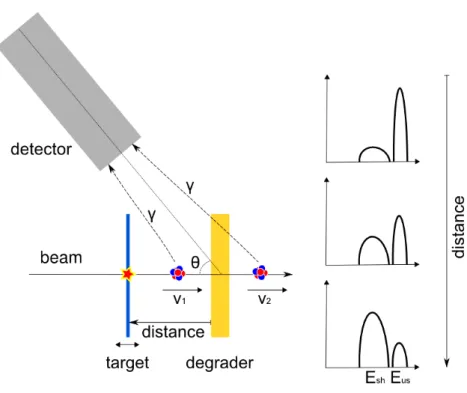
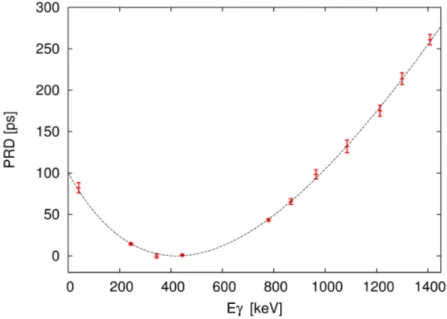
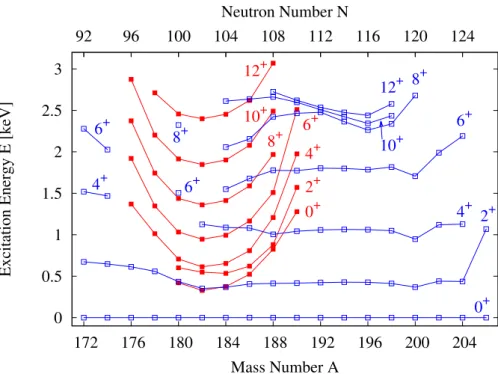
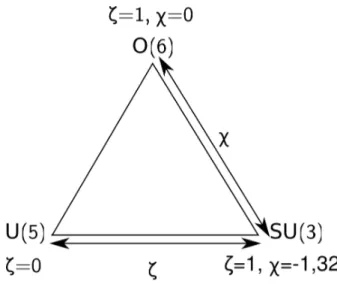
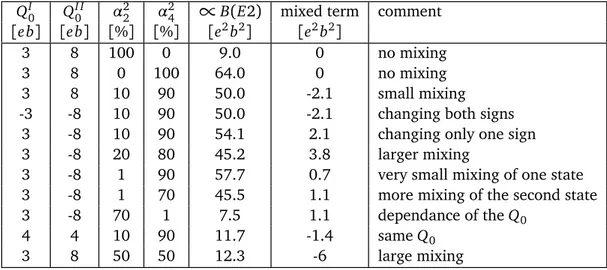
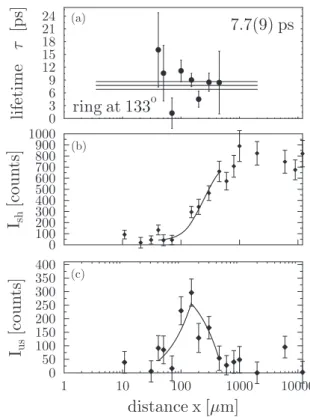
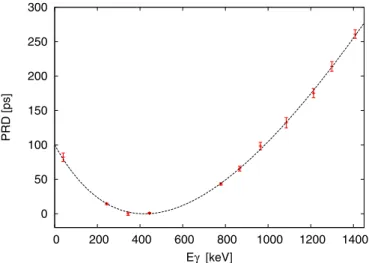
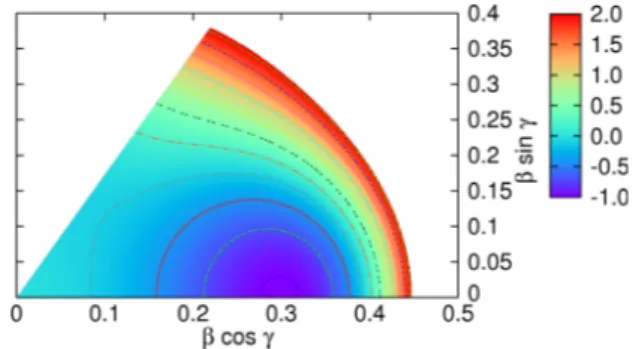
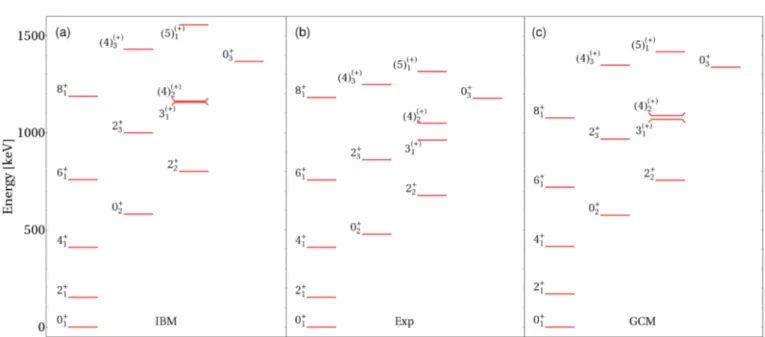
![TABLE II. Derived absolute B ( E 2) values from the experiments for the yrast band transitions in e 2 b 2 as well as relative B ( E 2) values from known branching ratios [28] for the states in the β and γ bands and the third 0 + state](https://thumb-eu.123doks.com/thumbv2/1library_info/3701382.1506036/26.892.131.399.538.1022/table-derived-absolute-values-experiments-transitions-relative-branching.webp)